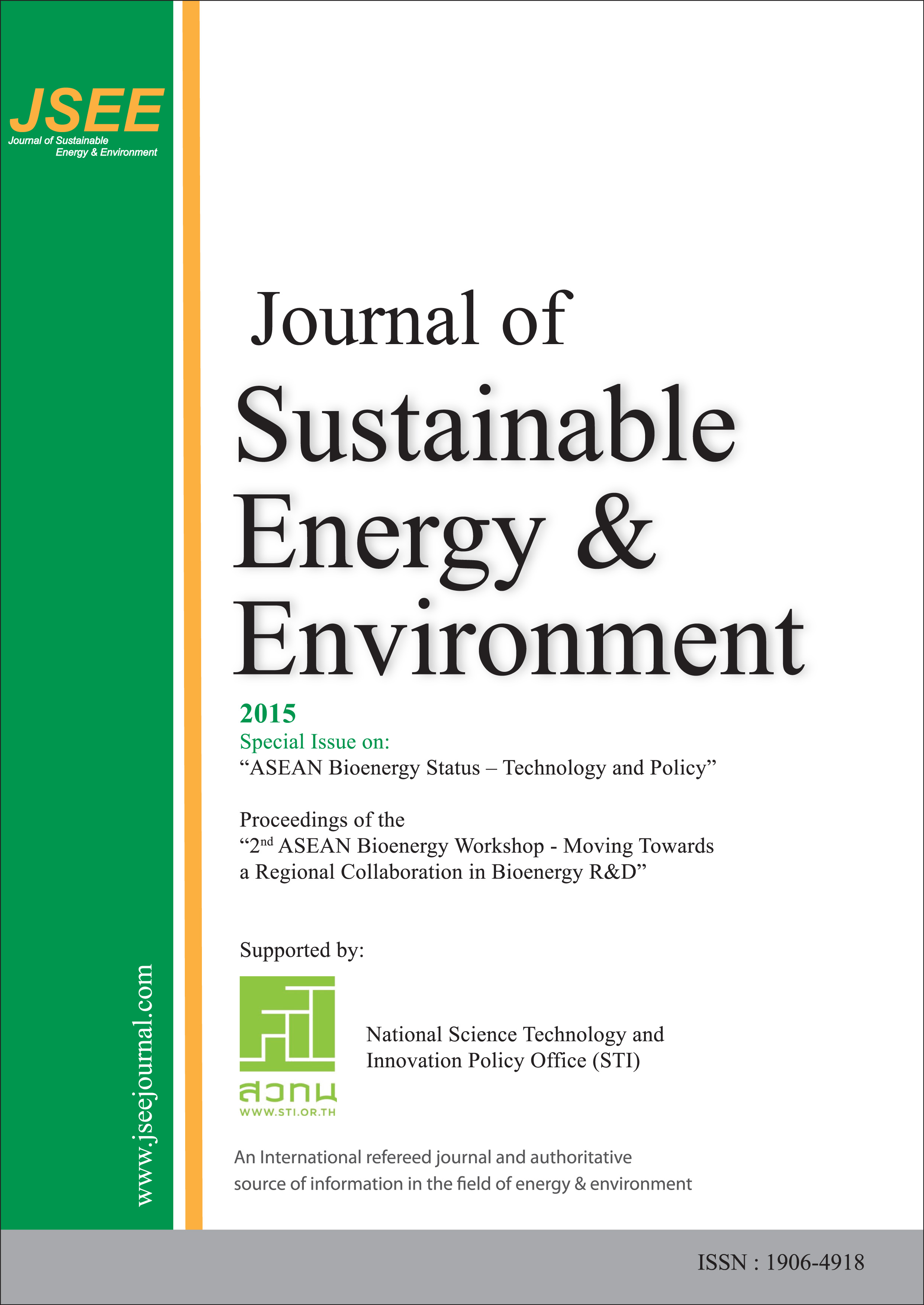
Suneerat Fukuda
Abstract: The aim of this paper is to present the bioenergy implementation and R&D in Thailand. The paper first briefly introduces the current status bioenergy production and utilization in Thailand as well as the promotion policy and target of renewable energy in 2021. The main part of the paper is an overview and status of R&D activities in bioenergy in Thailand. Information about past and ongoing research studies for different technologies along the biomass supply chain is reviewed. They include yield improvement technologies, thermochemical technologies (combustion, gasification and pyrolysis), anaerobic production technologies and liquid biofuel production technologies.Keywords: Biomass, Bioenergy, R&D, Thailand.

Tang Kok Mun
Abstract: Sustainable development has always been one of Malaysia’s key macro agenda that covers the three areas of development i.e. social, economy and the environment. Within this context, the biomass industry offers tremendous opportunity for Malaysia to achieve this agenda. The agricultural sector generates large amount of biomass, that just two decades ago was considered a waste but now increasingly valued as a resource for economic exploitation.The amount of biomass generated annually in Malaysia totals to about 96 million tonnes (wet). The types of biomass available include palm-based biomass (empty fruit bunches, kernel shell, mesocarp fibers and liquid effluent), rice-based biomass (rice husk and straw), forestry waste (saw dust, timber offcuts), rubber wood as well as municipal solid waste. It is estimated that optimum utilization of these biomass resources will generate gross national income of USD 5-10 bil. per annum with total investments of USD15-20 bil.Malaysia is presently moving towards achieving higher level of economic and environmental sustainability via the utilization of the biomass resources in areas such as bio-energy generation, production of compost and biofertilisers, manufacturing of eco-products as well as production of bio-based fuels and chemicals. Both large corporations as well as the small and medium enterprises (SMEs) are actively participating, investing and innovating in this new area of economy. The application of advanced biomass conversion technologies is also a key factor in producing high value products from the biomass resource.

Boualy Vongvisith* and Humpheng Theuambounmy
Abstract: Lao PDR lacks of conventional energy resources (e.g., Oil or Natural Gas) and 100% of fossil fuels are imported from abroad (mainly through Viet Nam and Thailand) that Fossil fuel consumption in Lao PDR is rising rapidly. In 2008, Lao PDR imported 558 million litres of fossil fuel, an increase from 450 million litres in 2006, which in 2010 will be 561 million litres and 716 million litres by 2015. Therefore, The government in Lao-PDR has planned for developing a strategic reserve of petroleum fuel to help meet the requirement of the country during times of crisis that the government of Lao PDR has provide several schemes for promotion of agriculture sector and renewable energy in the country. The Government aims to increase the share of renewable energies to 30% of the total energy consumption in 2025. To reduce the importation of fossil fuels, the Government outlines a tentative vision to reach 10% of the total transport energy consumption from biofuels is set for the same period.Keywords: Bioenergy, Science, Technology Innovation and policy.

Harwin Saptoadi
Abstract: Indonesia enjoys abundant supply of biomass, which is useful for energy production and several other purposes. The exploited biomass for energy production should be non-edible or industrial residues. Despite of huge bioenergy potential, most energy demand is covered by imported fossil fuels. Appropriate government policies are required to improve such an energy condition. For instance, energy demand in the future will be managed efficiently and covered mainly by renewable energy and the fewer rest by fossil fuels. Road maps for biofuel production and mandatory use until 2025 have been launched. Feed-in-Tariffs for electricity generated from biomass, biogas and MSW have been introduced and revised several times in order to attract more investors. However, many barriers for improvements must be overcome, especially the existing fuel subsidy and poor support for bioenergy investment. Most electricity generated by private companies are off-grid and used internally for production process. Blending of diesel fuel and FAME was introduced since 2006 and recently it reaches B-10. Real experiments with B-20 are conducted currently on streets and highways. On the contrary, that of gasoline with bioethanol, which was launched in 2006 as well, is not produced anymore since 2010 due to unfavorable prices and limited raw materials.Keywords: Bioenergy; biofuel; feed in tariff; fuel subsidy; national policy; road map.

Kulwarang Suwanasri, Sivalee Trakulvichean*, Uthaiwan Grudloyma, Warinthorn Songkasiri, Terry Commins, Pawinee Chaiprasert and Morakot Tanticharoen
Abstract: ASEAN countries have high potential for developing biomass energy from wastes and wastewater. Biogas is one of the renewable energy sources that can be used as both heat and electricity. The aim of this paper is to present the current status of biogas technology, biogas purification technology and biogas utilization in Thailand. Biogas utilization at the domestic level has met with varying success, both in Thailand and other nations. Key to success in Thailand has been the focus on treating agricultural and agro-industrial waste streams, with biogas being a useful byproduct of this approach. The data was collected from primary and secondary sources from interviews with technology vendors, technology users and policy makers in Thailand. This paper gives an overview of the development of biogas technology and measures and strategies in promoting biogas production and utilization, as well as providing a successful model to increase biogas utilization in cassava starch industries due to a high success output. Since 1984, anaerobic wastewater treatment has been developed to produce biogas in cassava starch factories. At the beginning, most factories were not interested to invest in biogas production due to the high investment cost. However, this changed radically with the introduction of new measures and strategies such as financial support, tax incentives, small power purchase tariff (SPP) and environmental law enforcement. The key success factors to promote biogas utilization are the result of four important approaches, policy, technology, incentives and maintenance.Keywords: Cassava starch, food industry, industrial waste, policy, incentives, ASEAN.